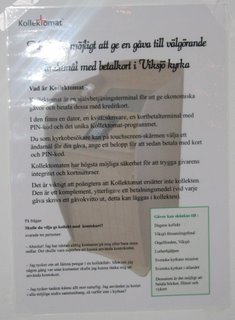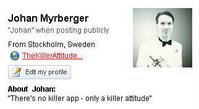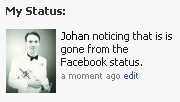Time for some more
Facebook statistics. You might remember my
other posts on the topic?
This time we will look at several aspects:
- Did the Facebook growth continue to decline as I noticed last time?
In my last post with Facebook statistics I noticed that the growth had declined, and actually turned into a decrease. What happened since then?
- New countries added to the set of data - what does the penetration league look like?
To the initial list of 31 countries an additional 16 is added. Who's in the lead for largest Facebook penetration right now?
- But is the data for the new 16 countries complete?
Hey, there seems to be something odd with the data for new countries added. What? Can you spot it?
(Note: If you don't see any tables below it is probably because you are reading this post via a feed reader. For some reason not all my embedded stuff seems to get through. If so, visit TheKillerAttitude.com to see the tables.)
Did the decline contine?
Have a look at the table below:
This is the growth rate each week for 31 countries (growth of number of users as found in the Social Ad utility).
The countries are ranked according to the overall growth since 1st of November. At the top Turkey has increased the number of users with almost 600%. At the bottom of the list you find Canada with a 10% increase.
The quite red column for Nov. 22nd was when I blogged about this last time. You see that the growth came back the two following weeks.
Dec. 13th is an all-nil column. Apparently the data was not updated at all. This was also the day I noticed the 16 new countries added (see below).
The Dec. 20th column is a very moderate growth week. Why? And compare the discussion on the new countries further down!
What is the usage penetration per country?
That is outlined in the table below. Country population figures are from the CIA factbook.
Note that Canada (with the lowest growth above) comes out on top.
Now, in this table you also find the 16 new countries for which the data is available (as no historic data was around the growth rate could not be calculated). The new countries are marked with yellow in the table.
Among the top ten on the list the only rank change is that Singapore overtook US (!) in penetration. Sweden is still at #4.
Is the data for the new countries complete?
Hm, well. Let us take in consideration the number of Facebook users that have registered in a national network. Next calculate the ratio between the number of people registered in the national network and the number of users in the country.
Below is a table with this ration for all the 16 new countries and some of the other. The list is sorted in descending order of this ratio.
See something strange?
All the new countries come out on the top, all with a ratio higher than 1 (100%).
Meaning that there is more people registered in the national network than user from the country. And this for all of the new countries.
I can't resist to quote Shakespear: "Something is rotten in the state of Denmark" (Hamlet, Act 1, scene 4), as Denmark is among these new countries.
Surely this indicates that the number of users for these 16 new countries are lower than the actual figure. Expect these to grow as Facebook fixes the data. We'll keep an eye on this!
Can this also explain the somewhat low overall growth the last week?
(As the tables will not get indexed I add this: Facebook statistics for
Turkey Israel France Malaysia Singapore China Switzerland Colombia Italy Germany India Spain Ireland Netherlands Australia Saudi Arabia New Zealand Mexico Egypt Lebanon United Arab Emirates Pakistan Dominican Republic Japan Sweden South Korea, Republic of Korea United Kingdom Norway United States (US) South Africa Canada Philippines Indonesia Russian Federation (Russia) Greece Denmark Finland Chile Belgium Argentina Venezuela Austria Jordan Peru Kuwait Thailand Panama)
Labels: facebook, facebookstats

 Of course there is a business opportunity here as well. I haven't looked at the business case, but
Of course there is a business opportunity here as well. I haven't looked at the business case, but 
